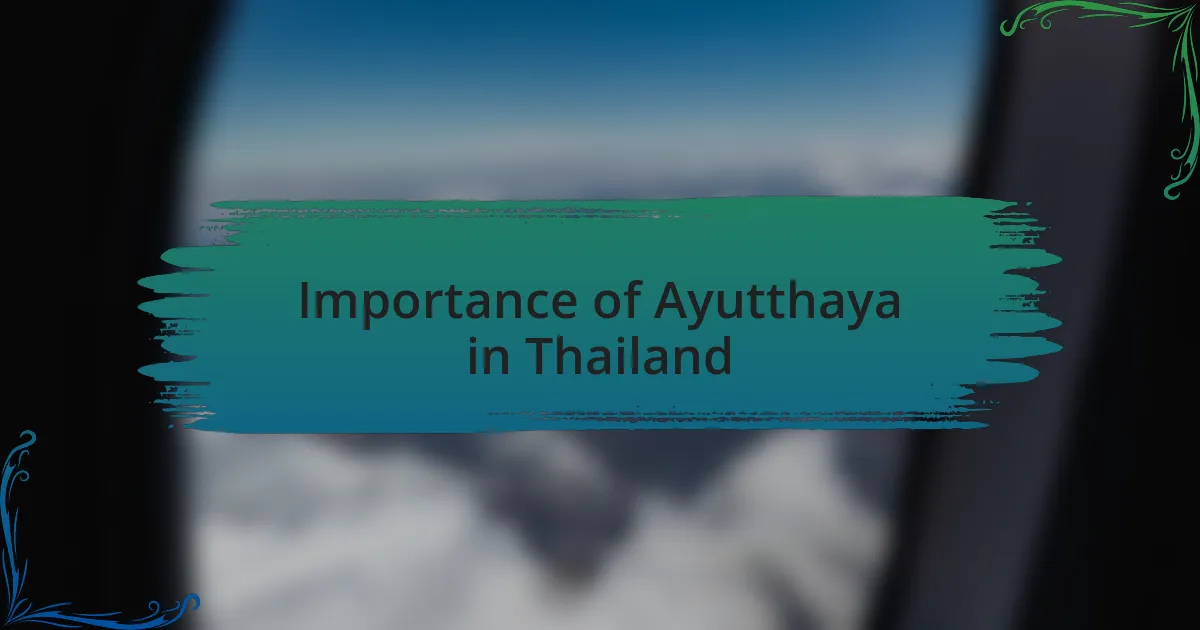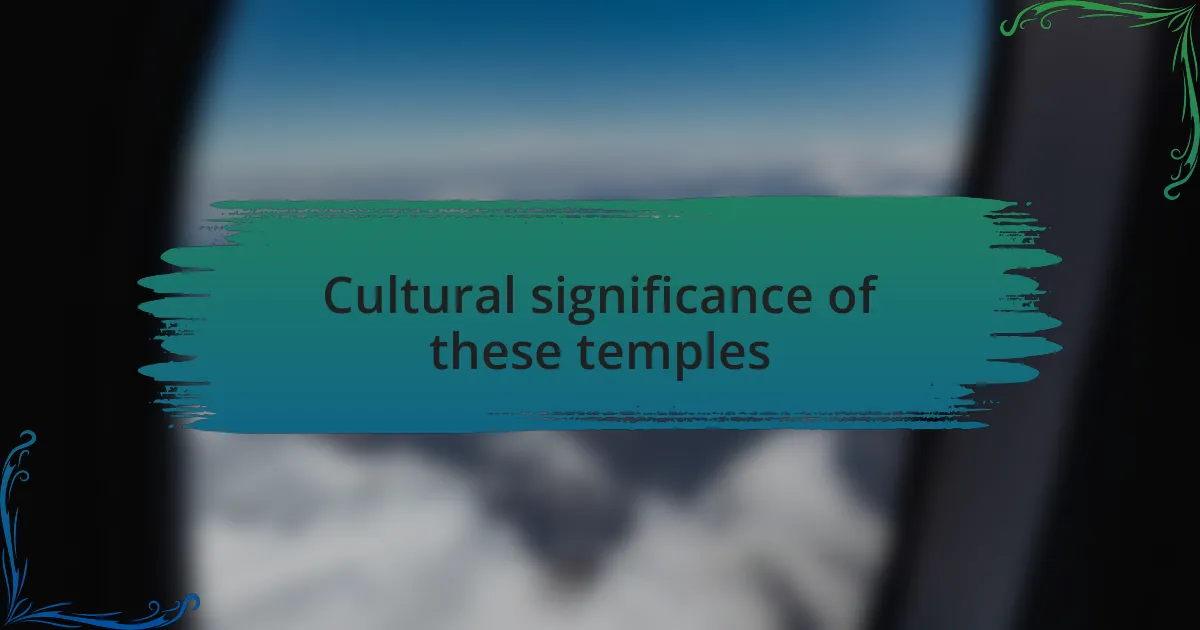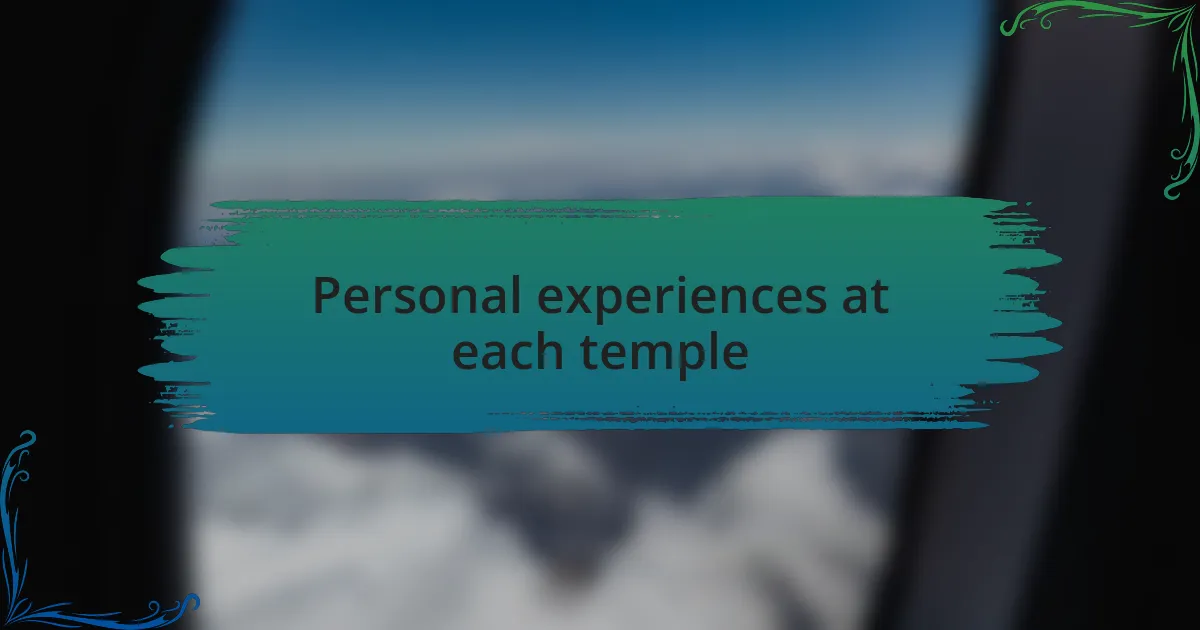Key takeaways:
- Ayutthaya’s temples are iconic historical sites that showcase Thailand’s architectural brilliance and spiritual heritage.
- The city symbolizes resilience, having flourished for over 400 years and undergoing restoration after devastation in the 18th century.
- Personal experiences, such as meditating at sunset or connecting with local monks, enhance the understanding of the temples’ cultural significance.
- Exploring Ayutthaya by bicycle and visiting at sunrise offers unique perspectives and moments of reflection among the ancient ruins.

Overview of Ayutthaya temples
The temples of Ayutthaya are a breathtaking testament to Thailand’s rich history and architectural brilliance. Walking through these ancient ruins, each structure tells a story, inviting visitors to ponder the past. Have you ever stood in the shadow of a towering stupa and felt a chill run down your spine, imagining the rituals that once took place there?
Among the most iconic sites, Wat Phra Si Sanphet stands out with its three impressive chedis. I remember the first time I laid eyes on those majestic structures; they seemed to rise from the earth like guardians of a forgotten era. The peaceful ambiance creates a perfect backdrop for reflection and introspection. Did you ever wonder how many generations have come and gone while these temples silently witnessed the flow of time?
As you wander through the historical park, the exquisite details of each temple become apparent—be it the intricate carvings or the serene Buddha statues that seem to exude wisdom. It’s impossible not to feel a connection to the spiritual energy that still lingers in the air. Isn’t it fascinating how these remnants of an ancient civilization continue to inspire awe in those who visit?

Importance of Ayutthaya in Thailand
The significance of Ayutthaya in Thailand goes far beyond its stunning architecture; it is a symbol of the country’s resilience and rich cultural heritage. Walking through the ruins, I often reflect on how this ancient city flourished as a capital for over 400 years. It makes me wonder: what remarkable exchanges of culture and trade transpired within those walls that shaped Thailand as we know it today?
The ruins of Ayutthaya also serve as a potent reminder of the forces that challenge civilizations. After being devastated in the 18th century, the city’s restoration became a testament to the strength of the Thai people. I vividly recall standing in front of the massive Buddha head entwined in tree roots and feeling a profound connection to history—a reminder that even in destruction, beauty and hope can emerge. How does this resilience speak to you as we face our own challenges today?
Visiting Ayutthaya feels like stepping into a living history book, where every temple and statue reveals chapters of Thailand’s narrative. Each visit brings fresh insights; I’m often amazed by how these ruins connect us to a time when art, spirituality, and community thrived. Isn’t it incredible to think about how many lives intersected in this vibrant city, leaving their mark on the cultural tapestry of Thailand?

Travel tips for Ayutthaya
When visiting Ayutthaya, I highly recommend renting a bicycle as it’s one of the best ways to explore the expansive ruins. I remember gliding past ancient temples with the wind in my hair, feeling a sense of freedom and connection to the past. Isn’t it exhilarating to discover hidden gems at your own pace?
Timing your visit can also make a significant difference. I’ve found that arriving early in the morning not only helps you avoid the crowds but also allows you to witness the temples bathed in soft, golden light. Have you ever watched a sunrise over a historical site? It’s a breathtaking experience that fills you with a sense of peace and gratitude.
Don’t forget to stay hydrated and protect yourself from the sun! I learned this lesson the hard way during one unforgettable summer visit when I underestimated the heat. Keep a water bottle handy and wear sunscreen—it’s essential when you’re wandering through this open-air museum. How do you ensure your comfort while exploring?

How to reach Ayutthaya
Reaching Ayutthaya is quite straightforward, and I love how accessible it is from Bangkok. I usually take the train from Hua Lamphong Station, which offers a relaxing journey through lush landscapes. There’s something special about watching the scenery change as I leave the hustle of the city behind. Have you ever enjoyed a train ride that felt like a mini-adventure?
If you prefer a faster option, a bus from Mo Chit Terminal will get you there in about an hour and a half. I remember one trip where I met a fascinating fellow traveler who shared tips on the best temples to visit. Engaging with locals or other travelers can enrich your experience in unexpected ways.
For those who appreciate a more personal touch, hiring a private car or taxi is also a great choice. I once opted for this option and relished the convenience. It allowed me to stop at scenic spots along the way, making the journey just as enjoyable as the destination. Isn’t it great to have the flexibility to explore at your own pace?

My top temples to visit
When it comes to must-visit temples in Ayutthaya, Wat Mahathat is always at the top of my list. I remember the first time I laid eyes on the iconic Buddha head entwined in tree roots; it was a moment that left me in awe of the ancient history wrapped within this site. Have you ever stood in a place so rich with stories that you could almost hear the whispers of the past?
Another gem is Wat Phra Si Sanphet, where the majestic chedis rise against the sky, creating a striking silhouette at sunrise. I’ve found this temple invites a sense of peace and reflection, especially as the morning light casts a warm glow. It’s hard not to be moved by the beauty and grandeur that once reflected the power of the Ayutthaya Kingdom.
Finally, I can’t recommend Wat Chaiwatthanaram enough. Its unique Khmer-style architecture always feels like stepping back in time. I still vividly recall the serene atmosphere as I strolled around the temple grounds, where the golden sunset created a picture-perfect backdrop. Have you ever felt a connection to a place that resonates so deeply within you?

Cultural significance of these temples
The cultural significance of the temples in Ayutthaya extends beyond their stunning architecture; they are testaments to the vibrant history of the region. When I walk through the remnants of these ancient structures, I’m often reminded of the spiritual practices that shaped the daily lives of the people long ago. It amazes me how these sites have served as places of worship, community gatherings, and centers of learning, bridging the past with the present.
Each temple I visit feels like a book filled with stories waiting to be discovered. For instance, I recall standing in Wat Mahathat, surrounded by intricate carvings that speak volumes about the artistry of the time. It made me wonder: how many generations have walked these grounds? The layers of history and faith intertwined within their walls create a deep cultural tapestry that enriches understanding of Thai heritage.
Moreover, these temples are not just historical markers—they are living symbols of resilience and spiritual devotion. During my visit to Wat Phra Si Sanphet, I felt a profound connection to the lineage of rulers who once frequented its grounds. It’s remarkable to think about how these spaces have endured the test of time, witnessing the rise and fall of empires while continuing to serve as a source of inspiration and reverence for future generations.

Personal experiences at each temple
Standing among the ruins of Wat Ratchaburana, I remember being captivated by the towering prang and its serene ambiance. As I climbed to the top, my heart raced with anticipation. The view over the temple complex was breathtaking, and I couldn’t help but think about the countless worshippers who must have sought solace in this sacred space. It filled me with a sense of gratitude for being part of such a rich history.
At Wat Chaiwatthanaram, I found myself lost in meditation as the sun began to set behind the temple’s silhouette. The golden light illuminated the brickwork in a way that seemed almost magical. I felt a profound sense of peace wash over me, prompting the question: how many others have stood here, reflecting on their lives like I did? It was a moment of connection, a silent acknowledgment of the countless souls who have sought serenity in this hallowed ground.
During my visit to Wat Phra Mahathat, I encountered a local monk who shared stories about the temple’s significance. I was genuinely moved as he recounted how the temple has remained a place of worship despite the ravages of time. His passion was infectious. In that moment, I realized that my experiences in these temples were not just about sightseeing; they were about connecting with the enduring spirit of the Thai people and their devotion to their faith.